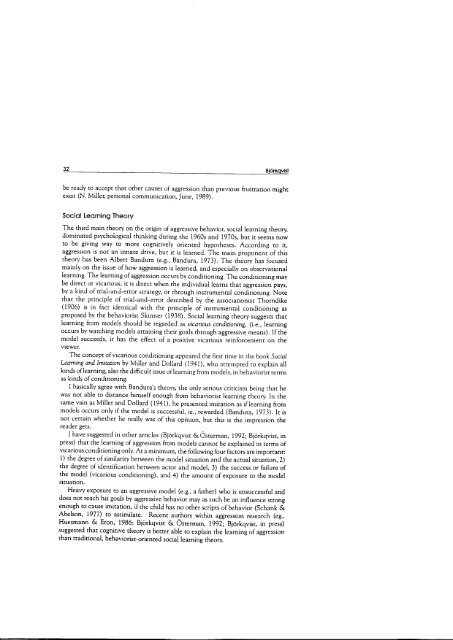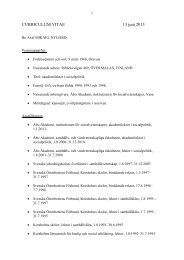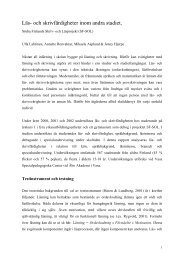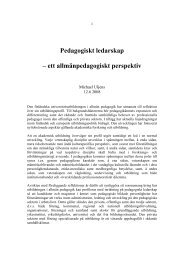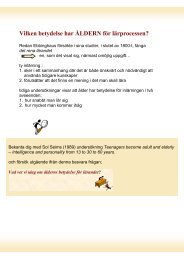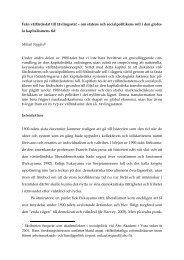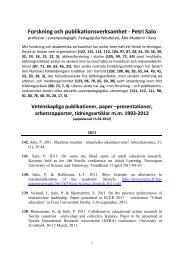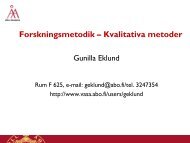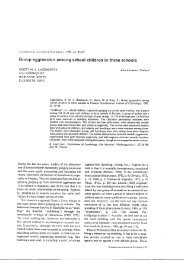Theoretical Considerations on Conflict and Aggression
Theoretical Considerations on Conflict and Aggression
Theoretical Considerations on Conflict and Aggression
You also want an ePaper? Increase the reach of your titles
YUMPU automatically turns print PDFs into web optimized ePapers that Google loves.
32 Bi6rkqvislbe ready to accept that orher causes of aggressi<strong>on</strong> than previous fiustratio^ mightexist (N. Miller, pers<strong>on</strong>al communicati<strong>on</strong>, June, 1989).Sociol Leorning TheoryThe third main theory <strong>on</strong> rhe origin of aggressive behavior, social learning theory,dominated psychological chinking during rhe 1960s <strong>and</strong> 1970s, but ir seems nowto be giving way ro more cognirively oriented hypocheses. According ro it,aggressi<strong>on</strong> is not an innare drive, but ir is learned. The main prop<strong>on</strong>ent of thischeory has been Albert B<strong>and</strong>ura (e.g., B<strong>and</strong>ura,1973). The theory has focusedmainly <strong>on</strong> rhe issue of how aggressi<strong>on</strong> is learned, <strong>and</strong> especially <strong>on</strong> observari<strong>on</strong>allearning. The [earning of aggressi<strong>on</strong> occurs by c<strong>on</strong>diri<strong>on</strong>ing. The c<strong>on</strong>diti<strong>on</strong>ing maybe direct or vicarious; ic is direct when the individual learns rhat aggressi<strong>on</strong> pays,by a kind of trial-<strong>and</strong>-error srrategy, or through instrumenral c<strong>on</strong>diri<strong>on</strong>ing. Notethat the principle of rrial-<strong>and</strong>-error described by rhe associaci<strong>on</strong>ist Thorndike(1906) is in facr identical wirh rhe principle of instrumenral c<strong>on</strong>diri<strong>on</strong>ing asproposed by rhe behaviorist skinner (191s). social learning cheory suggests thatlearning fiom models should be regarded as vicarious c<strong>on</strong>diti<strong>on</strong>ing, (i.e., learningoccurs by warching models attaining rheir goals through aggressive means). If rhemodel succeeds, it has the effect of a positive vicarious reinforcemenr <strong>on</strong> theviewer.The c<strong>on</strong>cept of vicarious c<strong>on</strong>diti<strong>on</strong>ing appeared the first rime ir.r rhe book socrarI*arning <strong>and</strong>lmitati<strong>on</strong> by Miller <strong>and</strong> Dollard (1941), who atre.rpted ro explain allkinds of learning, also rhe difficult issue of learning fr<strong>on</strong>r nrodels, in behavioristermsas kinds of c<strong>on</strong>diti<strong>on</strong>ing.I basically agree with B<strong>and</strong>ura's theory, the <strong>on</strong>lv serious criticism beins rhat hewas nor able ro disrance himself enough from behaviorisr lea.ring rheory. In thesame vain as Miller <strong>and</strong> Dollard (1941), he presenred imicari<strong>on</strong> as if learning frommodeis occurs <strong>on</strong>ly if the model is successful, ie., rewarded (B<strong>and</strong>ura, r9z3). It rsnot certain whether he really was of this opihi<strong>on</strong>, but rhis is the inrpressi<strong>on</strong> thereader gets.I have suggested in other articles (Bjdrkqvist&Osrerman, 1992; Bjorkqvist, rnpress) that the learning of aggressi<strong>on</strong> from models cannor be explained i' rerms ofvicarious c<strong>on</strong>diti<strong>on</strong>ing <strong>on</strong>ly. At a minimum, the following four facrors are imporranr:1) the degree of similaricy between the model situati<strong>on</strong> <strong>and</strong> the acrual siruati<strong>on</strong>, z)the degree of identificati<strong>on</strong> berween acror <strong>and</strong> model, 3) rhe success or failure ofthe model (vicarious c<strong>on</strong>diti<strong>on</strong>ing), <strong>and</strong> 4) the amounrofexposure ro the modelsituati<strong>on</strong>.Heavy exposure to an aggressive model (e.g., a father) who is unsuccessfur <strong>and</strong>does not reach his goals by aggressive behavior may as such be an influence sff<strong>on</strong>genough to cause imitati<strong>on</strong>, if the child has no orher scripts of behavior (Schank&Abels<strong>on</strong>, l9?7) to assimilate. Recent authors within aggressi<strong>on</strong> research (eg.,Huesmann & Er<strong>on</strong>, 1986; Bjorkqvist & Osterman, L99Z; Bjorkqvist, in press)suggested thac cognirive theory is berter able co explain the learning ofaggressi<strong>on</strong>rhan raditi<strong>on</strong>al, behaviorist-oriented social learning rheory.


